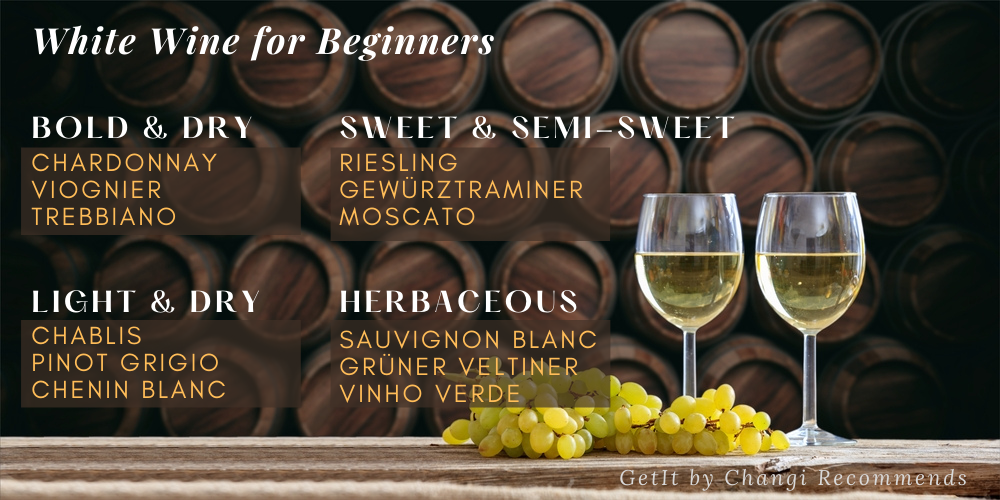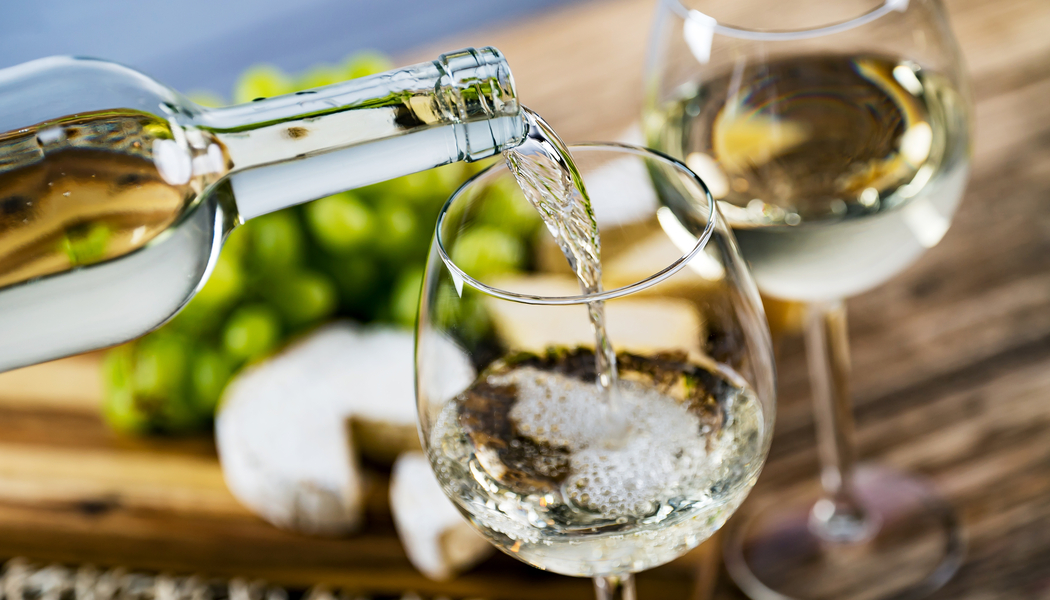You might be wondering to yourself, “what’s the difference between a light and a full-bodied white wine?”, “do I like something that smells floral or herbaceous?”, “would I enjoy something sweeter or a little drier?”
For some, picking a bottle of wine can feel much like driving without GPS, you’re not sure what to do, and you impulsively “wing it.” You just hope that you will eventually get it right and enjoy it. However, believe it or not, some of the world’s most expensive wines may not even be up to your liking (much like how some people loves bittersweet durians while others prefer something sweet).

Dry, fruity, grassy, herbaceous, mineral, citrusy, complex and sweet – the world of white wines can be overwhelming. Don’t panic. GetIt is here to demystify the world of wine for those who enjoy it but are intimidated by the prospect of shopping for it.
Arming yourself with a little knowledge goes a long way! We’ll help you become a white wine connoisseur by identifying the tastes, bodies, and varieties that are right for you in the rest of this post.
Essentially, winemaking is a form of agriculture. So let’s begin with how white wine is made.
How White Wine is Made
Chardonnay, Riesling, and Sauvignon Blanc are some of the popular white wine grapes. In fact, white wine can be made from both red and white grapes.
White wines, unlike red wines, are fermented without the use of grape skins, which is why their colours vary so drastically. During the fermentation process, the sugar and yeast in the grape pulp ferment into alcohol.
Then there’s another aspect that influences the taste of the wine. The winemakers either age the wine in oak barrels or bottle it after the fermentation process is completed.
What Does White Wine Taste Like
White wines come in a variety of flavours. Some white wines are extremely sweet, while others are bone dry.
White wines have lower tannin contents than red wine, and they tend to be less bitter and taste sweeter than their red counterparts. The most prominent flavours of white wines are lemon, grapefruit, apple, and peach.

What do you mean by full-bodied wine?
The body of a wine refers to its overall weight, “fullness,” and overall feel in the mouth. Similarly, the texture of water, low-fat milk and full cream milk are different, and in the world of wine, they are described as light, medium, and full-bodied.
Full-bodied wines are richer in flavour and texture than light-bodied wines, which are fruity and young. The amount of alcohol in white wine is often directly associated with the wine’s body, which is to say that lighter-bodied wine has lesser alcohol content.
Meat, poultry, pork, and fruit go well with white wines. Full-bodied white wines go well with heavier dishes like seafood pasta, grilled seafood, and cheese, while light-bodied wines go well with lighter seafood dishes. But there’s always Chardonnay, a medium to full-bodied white wine that pairs well with almost every dish.
What are light-bodied whites?
Light and refreshing on the palate, these light-bodied and dry whites are perfect for the weather in Singapore. They play really nicely with lighter dishes like grilled salmon, oysters, light pasta sauces, lemon basil chicken, and other white meats. Light-bodied wines typically boast an ABV of 12.5% or less.
Chablis: A 100% chardonnay wine from Burgundy, France, that tastes nothing like the oaky chardonnay you might think of as “typical.” It is rarely aged in oak. Wine-lovers often described it as mineral, elegant and clean, with a little lemon, lime and green apple. It’s dry yet mouthwatering with a tartness that is highly enjoyable with food.
Pinot Grigio (Pinot Gris): Pinot Grigio is the better-recognised Italian name for white French variety Pinot Gris. This grape variety can have a brownish pink to black and even white appearance. This dry white is known and loved for its zesty acidity and fruit flavours (lemons, limes, green apples, melons).
Grüner Veltliner: Small green-skinned grapes are cultivated almost exclusively in Austria, where their vineyards make up the majority (around 30%) of the total grapes production. In other words, it’s an Austrian white wine. Known for its mouthwatering tartness with intense notes of pepper and citrus fruits. While most white wines are ready to drink right away, grüner veltliner can be aged to add complexity to its flavour, and it will taste fuller-bodied.
Riesling: It’s arguably one of the most versatile food wines out there. Riesling ranges from sweet to off-dry (mild sweetness), and wine-lovers often described it as a lively, fruity and aromatic wine. Typically, riesling has stone-fruit-
Moscato: Made with muscat blanc grapes, Moscato is a popular option for those who are just getting started into the world of wine, especially for those with a sweet tooth! Moscato comes in many styles, from still to semi-sparkling and full-on bubbly and is typically well recognised for its sweet peach and orange blossom flavours.
What are some medium-bodied whites?
ABVs of 12.5% to 13.5% are common for medium-bodied wines. Scallops, sashimi, and salads pair well with these white wines.
Chenin Blanc: A white wine grape variety from the Loire Valley of France and a shining star in South Africa. The wine’s main flavours are floral and apple-like. Its high acidity means it can be used to make everything from sparkling wines to well-balanced dessert wines.
Sauvignon Blanc: This green-skinned grape is widely planted worldwide, from Bordeaux to New Zealand, California, and beyond. This varietal is highly terroir-driven, which is why you would find that a bottle of Sauvignon Blanc from New Zealand and California with a warmer climate tends to be herbaceous with pronounced tropical fruit flavours yet retaining a high level of acidity that is often described as crisp, elegant, and fresh. While the Old World’s Sauvignon Blanc from France is known to be earthy with citrus zest bite, depending on where it is produced, some can have oaky flavours of vanilla, cream, and nutmeg with medium to high acidity.
What are some full-bodied whites?
Full-bodied whites, with an alcohol level of 13.5% or higher, are noted for their flavour complexity. These wines go well with rich, buttery foods like lobster or cheese.
Chardonnay: The world’s most popular white wine because Chardonnay is rich, complex, and well-rounded. The taste profiles of this green-skinned grape variety run the gamut depending on the growing regions and ageing process. French chardonnay tends to feature citrus and flinty flavours, and California chardonnay is often aged in oak barrels (aka malolactic fermentation), which creates a buttery flavour and creamy texture. If you want a rich wine, go for an oaked Chardonnay; if you want something lighter and less buttery, go for an unoaked Chardonnay.
Viognier: It’s pronounced “vee-oh-nyay.” This full-bodied white from southern France is ideal for those who enjoy chardonnay but want to try something a little less acidic. Viognier boasts very fragrant floral notes, so it’s simultaneously full-bodied and creamy. The primary notes of Viognier are tangerine, vanilla and mango.
One last tip: when choosing your next white wine, be sure to pay attention to the sweetness level, and whether is it full and oaky or crisp and refreshing that gets your taste buds humming. For instance, if you enjoy Chardonnay but not too keen on the oak, you can consider a Chablis from Burgundy which is usually unoaked or lightly oaked.







